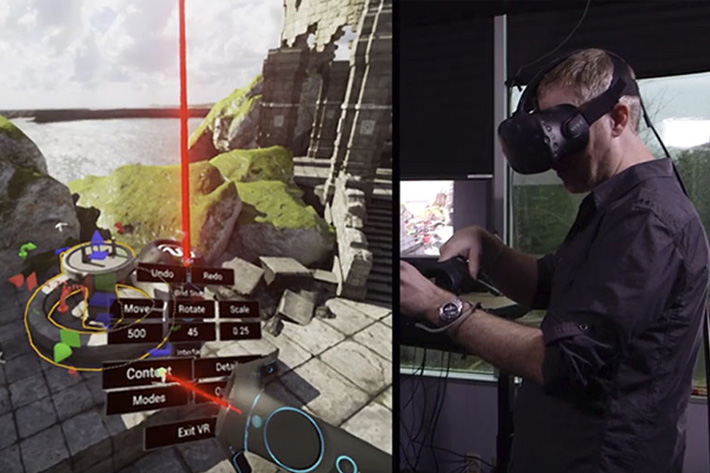
Epic Games went to NAB 2017 to reveal applications of their Unreal Engine that deliver unprecedented speed, fidelity and flexibility in broadcast production workflows.
Developed by Epic Games in 1998 as a PC games engine – and the base to the classic FPS Unreal computer game and the multiplayer Unreal Tournament – the Unreal Engine, now on its fourth version, is a high-performance software development suite that brings real-time, high-fidelity fully interactive experiences to, besides the PC, console, mobile, virtual reality (VR) and augmented reality (AR) platforms. Used by many of the world’s leading entertainment software developers and publishers, Unreal Engine is also an integral part of many enterprise sectors.
The Unreal Engine team supports and nurtures vertical markets such as automotive, architecture, film, science, aerospace, marketing and education that make use of real-time technology within their processes. The software is freely available at unrealengine.com. A preview of the next version, Unreal Engine 4.16, was launched during NAB 2017, and is now available to download. The actual stable version, 4.15, was launched last February. The software includes significant gains in overall stability, enhancements to developer workflows, and improvements to runtime performance resulting in greater efficiency during development and superior end user experiences after release.
The demonstrations presented at NAB 2017 reveal, for those not yet aware, that the Unreal Engine is much more than a… games engine. Ross Video, Vizrt and Zero Density demonstrated integrations with Unreal Engine that illustrate the power of the engine’s real-time rendering capabilities. In addition, The Future Group and House of Moves showcased how Unreal Engine is helping to break new ground in episodic entertainment production and delivery, during Epic’s first Unreal Engine NAB press conference.
Ross Video recently released Frontier by The Future Group, an innovative virtual studio graphics rendering platform that uses Unreal Engine to generate photoreal scenery for broadcast shows such as Fremantle’s Lost In Time. Frontier, produced in collaboration with Norwegian mixed-reality technology company The Future Group, works side-by-side with Ross Video’s XPression motion graphics system, taking full advantage of Unreal’s hyperealism capabilities and the workflow tools XPression offers.
“We’re very excited about Frontier,” said Gideon Ferber, Director of Marketing & Product Management for Ross Virtual Solutions. “Utilizing Unreal’s superior graphic capabilities in a virtual studio environment while maintaining the ease of use our UX control platform offers is a game changer in the virtual solution market space.”
Vizrt’s Viz Virtual Studio allows producers to easily create complex, interactive 3D virtual sets and immersive graphics using an intuitive interface. Virzt has added Unreal Engine to the Viz Virtual Studio workflow for accelerated real-time rendering. The updated solution, used by Fox Sports, BBC News, The Weather Channel and CNN was showcased at Virzt’s booth at NAB.
“Integrating Epic’s Unreal Engine 4 is bringing one of the world’s most powerful gaming engine into the Vizrt ecosystem. This opens up a complete new universe to our user base. The integration takes advantage of the features game engines have to offer, like interacting with game characters,” said Gerhard Lang, Vizrt Chief Engineering Officer.
Zero Density’s Reality Virtual Studio is a photoreal virtual studio solution that composites images in 3D space using the Unreal pipeline. Reality, the solution’s proprietary node-based 3D GPU-accelerated compositor, taps Unreal Engine as the 3D renderer to run in real-time. The combination of Unreal’s flexibility, power and rendering quality, and Zero Density’s keying, tracking and shading capabilities enable customers to achieve stunning creative for clients that include NEP and Groupe Media TFO. Zero Density also showcased end-to-end HDR and 4K UHD workflows, and a new augmented reality graphics pipeline at NAB.
“Unreal is the heart of our pipeline; its rendering quality and design process are unmatched. We’ve heard from customers that they will never build physical sets again based on what they can accomplish with Reality Virtual System and Unreal. Productions can be created on a grander scale, without limitations by physical space or budgets for set pieces,” said Kuban Altan, Head of Research and Development, Zero Density.
“Real-time rendering and compositing to produce final pixels is the holy grail for content producers, and Unreal Engine is the technology that can bring those workflows to life,” said Marc Petit, General Manager, Unreal Engine Enterprise at Epic Games. “We’re thrilled that so many of the biggest names in television technology and production are embracing the power of Unreal – and helping us bring real-time performance from the gaming world into broadcast, film and commercial entertainment.”
Although the future of Virtual Reality, where Unreal Engine is also used, as a mass market technology is still not a reality – and no one really knows if it will ever be – the software is not limited to VR, and can be used to build worlds for different platforms and also in augmented reality (AR), where we may see some more developments in the near future. Whichever way the technology and market go, the Unreal Engine appears as an excellent tool to help… tell stories. After all, that’s what the Unreal Engine was built for, in 1998, almost 20 year ago.
